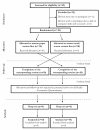Test-retest of computerized health status questionnaires frequently used in the monitoring of knee osteoarthritis: a randomized crossover trial
- PMID: 21851618
- PMCID: PMC3176488
- DOI: 10.1186/1471-2474-12-190
Test-retest of computerized health status questionnaires frequently used in the monitoring of knee osteoarthritis: a randomized crossover trial
Abstract
Background: To compare data based on touch screen to data based on traditional paper versions of questionnaires frequently used to examine patient reported outcomes in knee osteoarthritis patients and to examine the impact of patient characteristics on this comparison
Methods: Participants were recruited from an ongoing trial (http://ClinicalTrials.Gov Identifier: NCT00655941). 20 female participants, mean age 67 (SD 7), completed KOOS, VAS pain, function and patient global, SF-36, Physical Activity Scale, painDETECT, and the ADL Taxonomy. Patients were randomly assigned to one of two subgroups, completing either the paper or touch screen version first. Mean, mean differences (95% CI), median, median differences and Intraclass Correlation Coefficients (ICCs) were calculated for all questionnaires.
Results: ICCs between data based on computerized and paper versions ranged from 0.86 to 0.99. Analysis revealed a statistically significant difference between versions of the ADL Taxonomy, but not for the remaining questionnaires. Age, computer experience or education-level had no significant impact on the results. The computerized questionnaires were reported to be easier to use.
Conclusion: The computerized questionnaires gave comparable results to answers given on paper. Patient characteristics did not influence results and implementation was feasible.
Figures
Similar articles
-
Agreement between touch-screen and paper-based patient-reported outcomes for patients with fibromyalgia: a randomized cross-over reproducibility study.Scand J Rheumatol. 2015;44(6):503-10. doi: 10.3109/03009742.2015.1029517. Epub 2015 Jun 26. Scand J Rheumatol. 2015. PMID: 26114582 Clinical Trial.
-
Crosscultural Adaptation and Validation of the Korean Version of the New Knee Society Knee Scoring System.Clin Orthop Relat Res. 2017 Jun;475(6):1629-1639. doi: 10.1007/s11999-017-5307-8. Epub 2017 Mar 6. Clin Orthop Relat Res. 2017. PMID: 28265885 Free PMC article.
-
Usability of an innovative and interactive electronic system for collection of patient-reported data in axial spondyloarthritis: comparison with the traditional paper-administered format.Rheumatology (Oxford). 2013 Nov;52(11):2062-70. doi: 10.1093/rheumatology/ket276. Epub 2013 Aug 16. Rheumatology (Oxford). 2013. PMID: 23955646
-
Validity and reliability of the Persian versions of WOMAC Osteoarthritis Index and Lequesne Algofunctional Index.Clin Rheumatol. 2012 Jul;31(7):1097-102. doi: 10.1007/s10067-012-1983-7. Epub 2012 Apr 14. Clin Rheumatol. 2012. PMID: 22526476
-
The Dutch Lower Extremity Functional Scale was highly reliable, valid and responsive in individuals with hip/knee osteoarthritis: a validation study.BMC Musculoskelet Disord. 2012 Jul 2;13:117. doi: 10.1186/1471-2474-13-117. BMC Musculoskelet Disord. 2012. PMID: 22748143 Free PMC article.
Cited by
-
Readability of patient information and consent documents in rheumatological studies.BMC Med Ethics. 2016 Jul 16;17(1):42. doi: 10.1186/s12910-016-0126-0. BMC Med Ethics. 2016. PMID: 27422433 Free PMC article.
-
Measurement properties of UCLA Activity Scale for hip and knee arthroplasty patients and translation and cultural adaptation into Danish.Acta Orthop. 2021 Dec;92(6):681-688. doi: 10.1080/17453674.2021.1977533. Epub 2021 Sep 17. Acta Orthop. 2021. PMID: 34530681 Free PMC article.
-
Measurement properties of painDETECT: Rasch analysis of responses from community-dwelling adults with neuropathic pain.BMC Neurol. 2017 Mar 4;17(1):48. doi: 10.1186/s12883-017-0825-2. BMC Neurol. 2017. PMID: 28259159 Free PMC article.
-
Assessment of patient satisfaction, functionality, and quality of life after ultrasound-guided knee intervention: a prospective study.Clin Rheumatol. 2021 Feb;40(2):735-740. doi: 10.1007/s10067-020-05254-6. Epub 2020 Jul 4. Clin Rheumatol. 2021. PMID: 32623646 Clinical Trial.
-
Correlation of Self-Reported Questionnaire (KOOS) with Some Objective Measures in Primary OA Knee Patients.ISRN Rheumatol. 2014 Jan 16;2014:301485. doi: 10.1155/2014/301485. eCollection 2014. ISRN Rheumatol. 2014. PMID: 24527222 Free PMC article.
References
-
- Richter JG, Becker A, Koch T, Nixdorf M, Willers R, Monser R, Schacher B, Alten R, Specker C, Schneider M. Self-assessments of patients via Tablet PC in routine patient care: comparison with standardised paper questionnaires1. Ann Rheum Dis. 2008;12:1739–1741. doi: 10.1136/ard.2008.090209. - DOI - PubMed
-
- Harlin SL, Harlin RD, Sherman TI, Rozsas CM, Shafqat MS, Meyers W. Using a structured, computer-administered questionnaire for evaluating health-related quality of life in patients with chronic lower extremity wounds. Ostomy Wound Manage. 2009;12:30–39. - PubMed
-
- Thekkumpurath P, Venkateswaran C, Kumar M, Newsham A, Bennett MI. Screening for psychological distress in palliative care: performance of touch screen questionnaires compared with semistructured psychiatric interview. J Pain Symptom Manage. 2009;12:597–605. doi: 10.1016/j.jpainsymman.2009.01.004. - DOI - PubMed
Publication types
MeSH terms
Associated data
LinkOut - more resources
Full Text Sources
Medical



